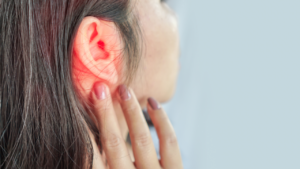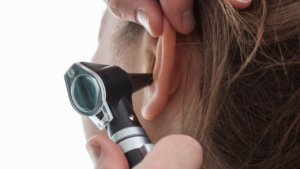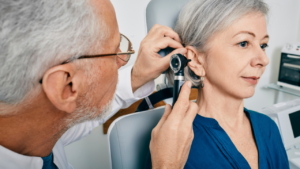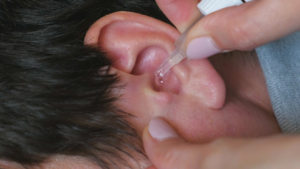
If you’ve ever experienced the discomfort or hearing issues caused by excess ear wax, you may have wondered about the best method of removal. One popular option is micro-suction, a safe and effective procedure that can quickly and painlessly clear out build-up in the ears. In this article, we will explore what micro-suction is, how it works, its benefits, potential risks, and how to prepare for a procedure. So, if you’re curious about this innovative ear wax removal method, keep reading to learn more.
Key Takeaways:
- Micro-suction is a safe and effective procedure for removing excess ear wax that can cause hearing impairment and discomfort.
- The procedure involves using specialised equipment to gently remove ear wax without the risk of pushing it further into the ear canal.
- Micro-suction is recommended for people of all ages and is a more effective option compared to other methods of ear wax removal.
What is Ear Wax?
Ear wax, also known as cerumen, is a naturally occurring substance produced by the glands in the ear canal to protect and lubricate the ear.
It serves as a barrier against dust, dirt, and bacteria, preventing them from entering the sensitive inner ear.
Cerumen also helps in cleaning the ear by trapping debris and pushing it out of the ear canal. The composition of ear wax consists of a mixture of secretions from sebaceous glands and sweat glands, along with dead skin cells. These components work together to maintain the delicate pH balance of the ear canal and prevent dryness or irritation. In rare cases, excessive ear wax buildup can lead to hearing problems, requiring professional removal.
What is Micro-suction?
Micro-suction is a modern ear wax removal technique that uses a gentle suction device to remove excess ear wax safely and effectively.
This advanced method stands out for its precision in targeting the wax without disturbing the delicate ear canal lining. Using a specialised, controlled suction apparatus, the procedure ensures a thorough removal of wax buildup, reducing the risk of injury often associated with traditional methods. The effectiveness of micro-suction is commendable, as it can efficiently address stubborn wax accumulations, providing relief from discomfort and restored hearing clarity. Patients often appreciate the quick and painless nature of this procedure, which is performed by trained professionals in an ear care clinic or healthcare setting.
How Does Micro-suction Work?
During a micro-suction procedure, a specialised suction device is used to gently extract impacted ear wax from the ear canal without the need for water or irrigation.
The key to the effectiveness of micro-suction lies in the device’s precision and controlled suction power. As the trained healthcare provider guides the device into the ear canal, it creates a seal that isolates the ear wax. This allows focused suction to delicately pull the wax out, layer by layer, without pushing it further in or causing discomfort.
The process ensures that only the excess ear wax is removed, leaving behind the necessary protective layer in the ear canal. This helps maintain the natural balance and prevents any damage to the ear structure. The flexibility and adaptability of the suction tool enable it to target different areas of the ear canal with varying degrees of buildup, making it a versatile and safe method for ear wax removal.
Is Micro-suction Safe?
Micro-suction is considered a safe procedure for ear wax removal, with minimal risk of complications such as ear infections or damage to the ear drum when performed by a skilled professional.
One of the key aspects that make micro-suction a preferred method is its gentle approach that lessens the likelihood of injury or discomfort compared to other techniques. The specialised tools used in micro-suction allow for precise and controlled removal of ear wax without causing trauma to the delicate structures of the ear. Professional expertise is crucial to ensure that the procedure is carried out effectively and safely, minimising the chances of complications. By avoiding potential harm to the ear canal, micro-suction offers a reliable and efficient solution for managing ear wax build-up while prioritising patient safety.
What Are the Signs of Excess Ear Wax?
Excess ear wax can lead to various symptoms, including earache, temporary hearing loss, dizziness, and a feeling of fullness in the ear.
When ear wax accumulates beyond normal levels, it may cause itching in the ear canal as well as a persistent ringing or buzzing sensation, known as tinnitus, which can significantly impact one’s quality of life. In severe cases, excessive ear wax can even lead to vertigo, a sensation of spinning or imbalance that disrupts daily activities.
If left untreated, excessive ear wax build-up can potentially contribute to ear infections and inflammation, posing risks to overall ear health.
How Does Excess Ear Wax Affect Hearing?
Excess ear wax can block the ear canal, leading to hearing difficulties and affecting sound transmission to the eardrum.
When the ear canal becomes blocked with excessive ear wax, it can directly impact how sound waves reach the eardrum. The build-up of wax can act as a barrier, hindering the efficient conduction of sound, resulting in muffled hearing or even temporary hearing loss. This obstruction not only interferes with sound transmission but can also lead to discomfort, dizziness, and in some cases, ringing in the ears (tinnitus).
Can Excess Ear Wax Cause Pain or Discomfort?
Excess ear wax build-up can result in pain, discomfort, and a sense of pressure in the ear due to the blockage it creates within the ear canal.
When ear wax accumulates excessively, it can not only cause physical sensations like aching and pressure but also impact hearing ability by muffling sounds and creating a sensation of fullness in the ear.
Proper ear hygiene plays a crucial role in preventing these issues as it reduces the risk of blockages that can escalate into more serious problems. The discomfort from an earache or the annoyance of constant itching could also point to the need for professional removal of impacted wax. If left unaddressed, blockages could even lead to more severe conditions such as infections or vertigo.
How is Micro-suction Performed?
Micro-suction is performed by a trained professional using a suction device and specialised instruments to remove ear wax safely and efficiently.
The process of micro-suction involves a series of precise steps to ensure effective ear wax removal. First, the professional will conduct a thorough examination of the ear canal using an otoscope to assess the amount and consistency of the wax. Next, they will use a specialised suction device, such as a microscope with a tiny vacuum attachment, to gently suction the wax out. The professional will carefully manoeuvre the instrument to target and extract the wax without causing any discomfort.
During the procedure, the patient may feel some mild pressure or a gentle pulling sensation as the wax is being lifted out.
What Equipment is Used for Micro-suction?
Micro-suction procedures utilise a suction device, a microscope or endoscope for visualisation, and specialised instruments to clear ear wax blockages safely from the ear canal.
The suction device creates a gentle vacuum to effectively extract ear wax without causing discomfort. Meanwhile, the microscope or endoscope provides a clear view of the ear canal, enabling the medical professional to precisely navigate and target the build-up. Specialised instruments such as fine probes and loops aid in delicately breaking down and extracting hardened wax. Precision is crucial in this process to avoid any injury to the delicate structures of the ear, highlighting the importance of trained professionals and proper equipment in ensuring a safe and effective procedure.
What Are the Steps of Micro-suction?
- The steps of a micro-suction procedure involve patient preparation, ear canal examination, wax removal using the specialised suction device, and post-procedure care for optimal ear cleaning.
- Before beginning the procedure, it is crucial to ensure that the patient is comfortable and informed about what to expect.
- The ear canal examination is done to assess the condition and location of the wax build-up. Using the specialised suction device, the audiologist delicately removes the excess wax, ensuring not to push it further into the ear.
- Post-procedure, patients are advised on aftercare instructions to prevent any potential complications and to maintain ear health.
What Are the Benefits of Micro-suction?
Micro-suction offers benefits such as quick and safe ear wax removal, precise cleaning of the ear canal, and reduced risk of complications compared to other methods.
One of the key advantages of micro-suction is its speed in removing ear wax. Unlike traditional methods that may take longer, micro-suction can quickly and effectively clear out blockages, providing instant relief to the individual. The safety aspect of this technique is unparalleled. The controlled suction ensures that only the excess wax is removed, minimising the risk of damaging the delicate structures of the ear.
The precision offered by micro-suction is another standout feature. The specialised equipment allows practitioners to target specific areas without causing any harm, making it an ideal choice for individuals with sensitive ears. The effectiveness of this method is remarkable. By thoroughly removing the wax build-up, micro-suction reduces the chances of recurring blockages, offering long-term benefits over other techniques.
Is Micro-suction More Effective Than Other Methods of Ear Wax Removal?
Micro-suction is considered more effective than traditional methods like ear irrigation or manual techniques in providing thorough and gentle ear cleaning without the use of water or manual instruments.
One of the key benefits of micro-suction is its precision, as it allows healthcare professionals to target specific areas in the ear canal with accuracy, minimising the risk of causing damage or irritation. Additionally, micro-suction is known for its quick and efficient removal of stubborn ear wax, making it a preferred choice for individuals with impacted wax or sensitive ear canals.
Is Micro-suction Recommended for Everyone?
Micro-suction is generally recommended for individuals with a history of ear wax buildup, those prone to ear infections, or those with contraindications to other methods of ear wax removal.
For individuals who have a tendency to develop impacted earwax or recurrent infections, micro-suction offers a gentle yet effective solution. It is particularly suitable for those with narrow ear canals who may find traditional ear syringing uncomfortable or ineffective. For individuals with a history of perforated eardrums, chronic ear conditions, or previous ear surgeries, micro-suction presents a safer alternative to manual ear cleaning methods. This method is ideal for people seeking a quick, thorough, and non-invasive approach to maintaining optimal aural health.
Are There Any Risks or Side Effects of Micro-suction?
Whilst micro-suction is generally safe, potential risks and side effects may include temporary dizziness, minor discomfort, or rare instances of damage to the eardrum if not performed correctly.
These risks are, however, quite uncommon when the procedure is carried out by experienced audiologists or ENT specialists who have undergone rigorous training. It is crucial that the professional performing micro-suction is well-versed in the intricacies of the ear anatomy and the technique itself to minimise the chances of any adverse effects. Skilled practitioners are adept at adjusting the suction pressure to ensure gentle but effective removal of earwax without causing harm.
How Can You Prepare for a Micro-suction Procedure?
To prepare for a micro-suction appointment, individuals should provide a thorough medical history, disclose any allergies or existing conditions, and follow any specific instructions given by the clinic or doctor.
Providing a detailed medical history is crucial as it allows the healthcare provider to tailor the procedure according to individual needs. Allergies should be clearly communicated to avoid any adverse reactions during the process. Adhering to the pre-procedural guidelines, such as refraining from using ear drops or other substances, can ensure the success of the micro-suction appointment. Remember, accuracy and openness in medical disclosure play a significant role in guaranteeing a safe and effective experience.
How Often Should You Get Micro-suction for Ear Wax Removal?
The frequency of micro-suction for ear wax removal varies depending on individual needs, with some individuals requiring treatment every few months while others may only need it annually.
It is essential to pay attention to any symptoms that may indicate a build-up of earwax, such as hearing loss, ear pain, or ringing in the ears.
Regular monitoring of these signs can help determine when a micro-suction procedure might be necessary.
Healthcare professionals recommend consulting with an ear specialist to establish a suitable frequency for ear wax removal based on the specific conditions of each individual’s ears.






